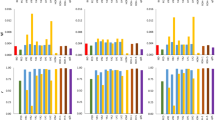Summary
For the measurements of outcrossing rates in plant populations, current electrophoretic procedures permit many loci to be scored per individual progeny. Given that the total experimental effort or cost is limited, the choice exists then between assaying a large number of loci on a restricted number of individuals, or assaying a large number of individuals at a few loci. Using simple models and the criterion of minimising the variance of the estimate, several factors which affect this choice are considered (levels of polymorphism, heterozygosity, linkage disequilibrium, pollen or outcrossing heterogeneity). The general conclusion is that the actual level of outcrossing is a major factor in determining experimental strategy. Maximum efficiency for estimating outcrossing in predominantly inbreeding plants comes from large samples assayed for few polymorphic loci. In contrast, in predominantly outcrossing plants, more loci should be assayed at the expense of sample size for improved statistical efficiency.
Similar content being viewed by others
Literature
Brown, A.H.D. (1979): Enzyme polymorphism in plant populations. Theor. Popul. Biol. 15, 1–42
Brown, A.H.D.; Allard, R.W. (1970): Estimation of the mating system in open-pollinated maize populations using isozyme polymorphisms. Genetics 66, 133–145
Brown, A.H.D.; Zohary, D.; Nevo, E. (1978): Outcrossing rates and heterozygosity in natural populations of Hordeum spontaneum Koch in Israel. Heredity 41, 49–62
Elandt-Johnson, R.C. (1971): Probability Models and Statistical Methods in Genetics. New York: Wiley
Green, A.G.; Brown, A.H.D.; Oram, R.N. (1980): Determination of outcrossing in a breeding population of Lupinus albus L. Z. Pflanzenzucht. 84, 181–191
Jain, S.K. (1961): A note on the estimation of natural crossing by the maximum likelihood method. Ind. J. Genet. Plant Breed. 21, 146–148
Harding, J.; Tucker, C.L. (1964): Quantitative studies on mating systems. 1. Evidence for the non-randomness of outcrossing in Phaseolus lunatus Heredity, 19, 369–381
Horovitz, A.; Harding, J. (1972): Genetics of Lupinus V. Intraspecific variability for reproduction traits in Lupinus nanus. Bot. Gaz. 133, 155–165
Morris, R.W.; Spieth, P.T. (1978): Sampling strategies for using female gametophytes to estimate heterozygosity in conifers. Theor. Appl. Genet. 51, 217–222
Ritland, K.; Jain, S. (1981): A model for the estimation of outcrossing rate and gene frequencies using independent loci. Heredity, 47, 35–52
Shaw, D.V.; Kahler, A.L.; Allard, R.W. (1981): A multilocus estimator of mating system parameters in plant populations. Proc. Nat. Acad. Sci. (USA) 78, 1298–1302
Author information
Authors and Affiliations
Additional information
Communicated by R. W. Allard
Rights and permissions
About this article
Cite this article
Shaw, D.V., Brown, A.H.D. Optimum number of marker loci for estimating outcrossing in plant populations. Theoret. Appl. Genetics 61, 321–325 (1982). https://doi.org/10.1007/BF00272848
Received:
Issue Date:
DOI: https://doi.org/10.1007/BF00272848




